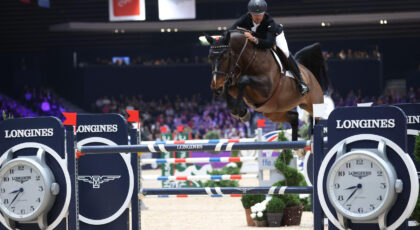Utrecht University’s Equine Clinic is performing cutting-edge biomechanics research that is reshaping how we think about the equine body and applying new technologies to enhance health.
Last month while I was in The Netherlands, a colleague, Dr. Joop Loomans, arranged a tour of Utrecht University’s Equine Clinic.
Dr. Loomans is a Past-Director of the Field Service of the Equine Clinic, and I was fortunate to have a behind the scenes look at the work being conducted here. The equine clinic is a world leader in veterinary medicine as well as sport horse research. The clinic has 85 stalls (divided into five wards), two operating theatres and a room for standing interventions, a teaching herd of 18 horses, an entire breeding facility, as well as numerous other amenities.
With a background in biomechanics (the study of biological systems’ structure, function, and motion), I was impressed by the work being done in Dr. Filipe Serra Bragança‘s lab. Dr. Serra Braganca is a vet and researcher in the Department of Clinical Sciences – Equine Sciences, at Utrecht University. The field of biomechanics has grown by leaps and bounds in the past five years, and a number of technologies being developed at Utrecht are providing exciting new insights that will change how we manage sport horses.
Using Cameras to Precisely Measure Movement in the Clinic
First, the majority of horses presented to the equine clinic for lameness or poor performance in Utrecht undergo a comprehensive movement assessment with a precise motion capture camera-based system when they first arrive. The camera system measures (within 1.5 mm) the location of the horse’s body as it walks or trots both in a straight line as well as on the lunge.l
The data is then processed and creates a model of the horse that can precisely quantify any movement asymmetries, range of motion for joints, and movement parameters such as stride length and vertical movement of the body. Note that the human eye requires approximately 20% asymmetry to be present before it can even be detected—so this system is much more sensitive to subtle movement differences than a human observer can be. And while there will always be some asymmetry present in the body, this system can help determine what is normal vs what is indicative of an underlying clinical issue.
The researchers are now using machine learning approaches to correlate findings from the camera movement assessment with injury diagnosis and recovery prognosis. The results will provide clinicians with valuable information about how certain movement patterns can represent specific injuries, and how these injuries respond to treatment.
Using EquiMoves to Assess Movement Anywhere
Dr. Serra Braganca and his team, in collaboration with other partners, have also developed technology that can measure horse movement without cameras. The new system, named EquiMoves©, has the advantage of being used anywhere since it does not rely on setting up a number of expensive cameras for each measurement. Instead, small wireless sensors are placed on the horse’s head, withers, pelvis, and legs.
From this system, researchers and clinicians obtain information about how the horse’s body is moving and where any asymmetries lie. With some calculations, the researchers are able to, for example, determine if one leg is ‘weak’ pushing off the ground, which can indicate an issue that needs further investigation. Due to its ease of use, a number of veterinarians have begun to use it in private practice to assess client horses for movement abnormalities.


Understanding Muscle Changes with Exercise and Injury
Lastly, Dr. Serra Braganca’s PhD student, Ineke Smit, has been working to optimize technology to measure muscle activation in horses during exercise. Using electrodes applied to the skin over targeted muscle groups, the electrical activity of muscle fibres can be recorded and studied. While researchers have been doing this process, termed surface electromyography or sEMG, in humans for decades, a number of logistical issues limited its usage in horses. However, Ineke is developing procedures that now allow for the use of sEMG with horses during exercise.
Information from Ineke’s work will be extremely valuable in equestrian sports as, to date, little is known about how a horse’s muscles are activated during exercise. For high-performance trainers and riders, obtaining this information will provide more clarity surrounding what muscles are active during what movements and what exercises target specific muscles for optimal development.
Summary
Recent technological advancements have made studying biomechanics in horses feasible. Detecting how movement changes throughout a horse’s career (and before an injury occurs), understanding muscle activation, and using machine learning to determine what factors cause injury and improve diagnostic accuracy are all important questions currently being studied.
Research like this is critical for supporting the welfare and performance of horses around the world. The Equine High Performance Sports Group (EHPSG) and The Sport Horse Research Foundation (SHRF) seek to advance and direct scientific research and education to enhance the health, athletic potential, and career longevity of sport horses. Contributions donated to the SHRF are fully tax-deductible and funds are used to support cutting-edge and impactful scientific studies. Donate here.




 October 12, 2021
October 12, 2021 




























